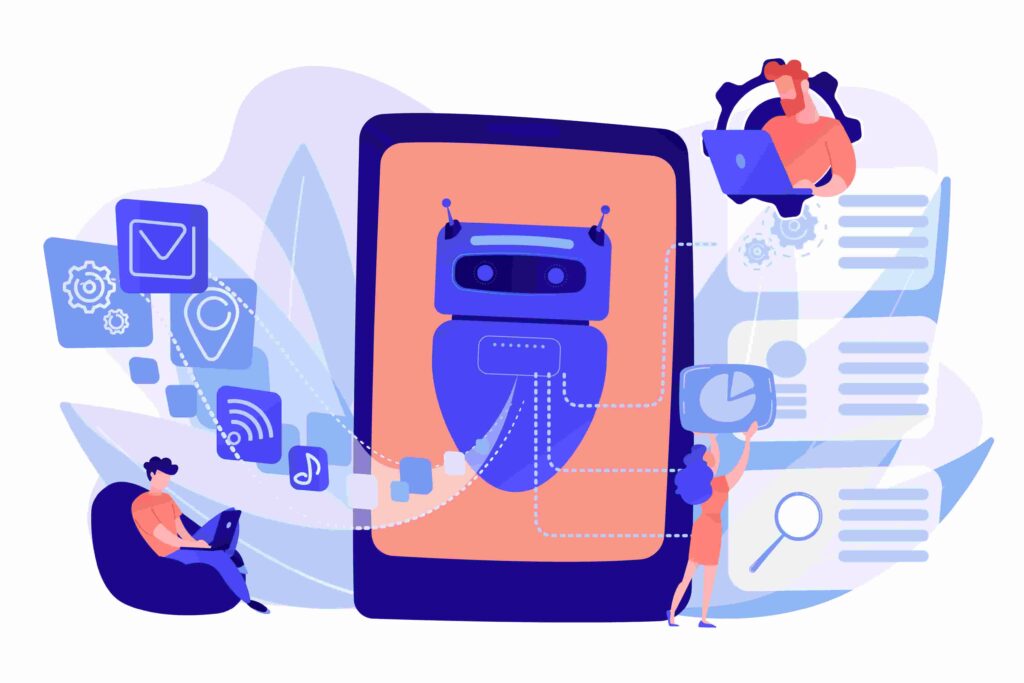Cybersecurity is a segment of IT that involves practices to protect digital information and reduce risks in applications, systems, and other IT assets.
With the huge amount of data that has been stored, processed, and interconnected between different online systems, the risks that may affect the information of companies have increased considerably. Today, cybercriminal use different methods of data breach and theft that can also compromise an organization’s strategic positioning.
Managers should be aware that investing in data security is also investing in the company’s competitive advantage.
However, information security and cybersecurity are not the same thing. This article will explain the difference between them and help you learn how to use cybersecurity as a competitive advantage.
This article addresses the following topics:
- Cybersecurity: what is it?
- Cybersecurity and information security are not the same thing
- Why we should invest in cybersecurity
- What kind of threats can cybersecurity avoid?
- How to use cybersecurity to protect your business
- The Milvus platform
Enjoy your reading!
Cybersecurity: what is it?
Cybersecurity refers to methods adopted by an organization to protect its digital information.
Cybersecurity is a set of methods and actions implemented to protect and ensure equipment and system security against intrusion. With internet popularization, cybersecurity practices have become widely used.
However, cybersecurity is often confused with information security. Although both concepts seek to protect the information of a company, cybersecurity is a practice that is part of information security. This is because information security must cover and protect the different types of assets (digital, physical, etc.).
That is, information security involves different responsibilities with different objectives. Cybersecurity, on the other hand, is an extremely important part of this whole.
Concept
Security professionals from the Information Systems Audit and Control Association (ISACA) define cybersecurity as:
“The protection of information assets by addressing threats to information processed, stored, and transported by internetworked information systems.”
Information systems involve applications, software systems, and other assets of information technology. They collect, process, and share digital data, and are potential targets of attacks and threats.
Therefore, cybersecurity protects a company’s digital information, such as:
- personal data of customers and users;
- financial information obtained from online systems;
- email history;
- cache or download files;
- files stored in a system;
- passwords;
- among others.
Cybersecurity and information security are not the same thing
As we have seen, these concepts, despite having the same objective of protecting the information of a company, are not the same thing.
Information security has a broader scope and covers all means of generating, collecting, or sharing data. Information security is responsible for creating and monitoring security plans for organizations like manufacturing facilities.
On the other hand, cybersecurity is part of information security, which aims to reduce or prevent system breaches that steal files stored digitally in devices, systems, or applications of a company.
Why we should invest in cybersecurity
Cybersecurity ensures benefits for companies, including optimization of IT team tasks.
When we talk about data security, it’s easy to understand how serious the situation can be and the need to invest in prevention systems. But besides that, cybersecurity systems offer other benefits, as described below.
Cybersecurity ensures data integrity
This is obviously the #1 advantage of cybersecurity: ensuring data integrity also means ensuring true and reliable information.
Can you imagine a manager making decisions based on data that cannot be validated? We’ve learned a lot about fake news lately, and the last thing you need is fake data for strategic decision-making.
Cybersecurity promotes effective change management
Do you work with change management processes? If your answer is no, then you should start thinking about it! Change management is a system that organizes all changes made to applications or systems, informing what has changed to the person in charge.
This way, the company has full control over changes or developments on its platforms. When an error or threat is identified, it is easier to find or undo the change that has caused that error or threat.
Cybersecurity helps the IT team
With cybersecurity actions, many risks can be mitigated. Then, the IT team doesn’t need to dedicate so much time to network monitoring and can focus on more strategic activities for the company.
Cybersecurity promotes competitive advantage
All decisions made by a company can influence consumer perception of its business. Therefore, a company committed to digital information security shows responsibility and digital maturity.
When considering the competition, cybersecurity acts as a competitive advantage, especially if data processing is related to the core business activity. In this case, information security and privacy are even more important for customers.
Do you know the regulations from the Brazilian General Data Protection Act (inspired by the European General Data Protection Regulation) for personal data security? It took effect in 2020 and refers to several aspects of cybersecurity.
What kind of threats can cybersecurity avoid?
You’ve already understood that cybersecurity is part of a company’s general security system, reducing or preventing threats that affect data integrity and business strategies.
But, after all, what threats are these?
You’ve probably heard of hackers or viruses – dangers that have existed since the beginning of the internet. Today, these and other problems can affect any user.
Of course, today many people know that, for example, a user should not open attachments in suspicious emails. However, threats are not always so obvious and easy to identify.
We describe below some of the main risks that a company may have. All of them can be avoided or controlled if the company adopts cybersecurity policies.
Malware
These types of virus are also known as “Trojan horses.”
They are software systems, that is, executable programs that, when installed on the computer, steal user’s data. They can also impair the operation of other systems and monitor user’s actions, stealing information such as banking passwords.
Backdoor
These threats are like malware but, when installed, can modify the entire infected system.
For example, files can be deleted, new programs can be installed, emails can be sent on behalf of the user, and the system can be perfectly operated as if it were a regular user.
Phishing
Phishing can seriously compromise a company’s security system. It happens because there are still several careless users who are affected by this malicious strategy. For instance, this is the case of emails sent by fake senders, who ask the user to take some action that causes virus installation.
This way, malicious systems can steal sensitive information such as passwords and bank information through imitation of trusted websites.
DDoS
DDoS, or Distributed Denial of Service, represents a threat that overloads servers, causing online websites or systems to go offline.
It consists of a master computer, which uses several other computers to attack a server. When it is overloaded with a very high number of simultaneous accesses, the website or system becomes unavailable. As a result, the company loses sales, important contacts or data.
Spoofing
This method spoofs the Internet Protocol (IP), pretending to be a trusted device, and then attacks other devices through damaged communication.
Internal attacks
Cybersecurity practices prevent both external and internal attacks, as malicious people can act inside an organization.
As internal users have access to internal systems and files, it is possible to infect information technology assets through the use of flash drive, malware installation, among others.
How to use cybersecurity to protect your business
Implement cybersecurity practices in your company and avoid threats that compromise your results.
Cybersecurity is critical for companies of all sizes and industries. It helps maintain data reliability and system operation, reducing system unavailability or risks that affect business results.
If you don’t know where to start, we offer some suggestions below:
Use encryption
Encryption is a kind of “code” that protects files, programs, or data. Even if someone has access to encrypted information, it cannot be read or understood, which makes it useless for those who stole it.
Develop a security policy
Every company needs a security policy that guides all employees and limits system access, among other things.
For example, one aspect to be addressed in a security policy is password management. The adoption of best practices for these decisions can ensure an important security standard at all levels of an organization.
Use certificate and digital signature system
Another critical aspect is the use of certificate and digital signature. This way, the company ensures legitimacy of the information sent.
This practice can also be seen as digital maturity, increasing customer confidence and satisfaction.
Be sure your systems are updated
The IT department must have system maintenance and upgrades under control. Outdated systems are easy entry points for cyber threats.
Every new update improves the security levels of systems and eliminates system flaws. So, if you don’t install system updates, you’re making systems open to vulnerabilities and risks.
Set up a VPN
A virtual private network (VPN) is a basic item of a cybersecurity system. VPNs allow employee mobility, that is, employees can work from home, without compromising security.
Imagine that an employee has access to confidential and strategic documents. In the company, the network is managed by the IT team. But if this employee accesses these documents using a different network, the security system may be compromised.
With a VPN, the company ensures its employees will access emails and files only if connected to a protected network.
Use cloud backup
Even if a company invests in cybersecurity, it is very difficult to completely eliminate the risk of attacks or keep the company 100% secure.
Therefore, consider cloud backup for your documents and data from time to time. Thus, in the event of an attack, previous versions can be quickly restored, free of threats.
Create a contingency plan
Contingency plans are required so that security professionals know what to do when an attack happens.
Let’s say your company has had a server attack and the website and other systems are unavailable. Until the situation is resolved and controlled, will the company’s website remain offline, without new sales?
Solutions like extra servers can be adopted until the infected server is fixed.
Contingency plans guide the team and speed up decisions for more effective crisis management.
Control access to your network
Can you monitor all accesses to your network? With a network scanner, for instance, you check all devices connected to your network. If you identify any device that is not included in your asset inventory, it can be a threat.
Train employees of all departments
Cybersecurity issues are closely related to the IT team. But the truth is that all professionals across the company must be aware of the risks and protocols in case of a threat.
As we have seen, attacks can happen in different ways. It only takes a click on a malicious link or an access to an untrusted website to put the whole company at risk.
Promote easy communication with IT
Last but not least: offer several contact channels with the IT department. This way, employees will be able to quickly contact the IT staff in case of any threat or strange situation.
One of these contact channels is a helpdesk, which offers a ticketing system to speed up the service. Systems to support the IT department, such as the Milvus platform, also offer intelligent asset and inventory management, which helps control and secure all devices.
Learn more about the Milvus platform! Take a free trial or request a demo.
Conclusion
Protect your business with a cybersecurity policy.
Cybersecurity is a well-known word, but companies still have a lot to develop in this area.
Although many people understand the risks and threats of digital exposure, they are not prepared to control or reduce these problems.
You can adopt a security policy, train employees to minimize potential risks, and invest in systems for easier management of your company’s assets.






